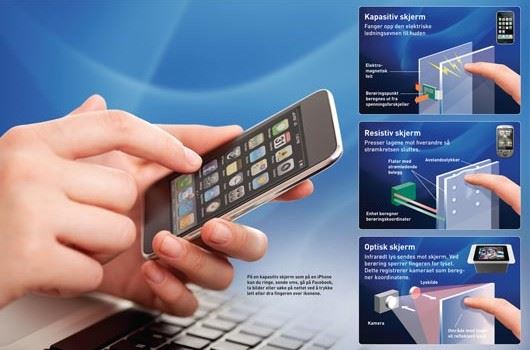The touch screen has evolved over time. Although many smart phones and personal digital assistants (PDAs) had touch screens long before Apple entered the market, the iPhone, introduced in 2007, was one of the first user-friendly smart phones with a touch screen.
Two types of technologies are commonly used in touch screens for mobile phones: capacitive (conductive) and resistive (the ability to provide resistance to electric current).
A capacitive screen relies on electricity and works by capturing the electrical conductivity of the skin on our fingertips. The screen is covered by a transparent, conducting material. When a finger touches the screen, the local electrostatic field is distorted. The sensors use this distortion to determine that the position of the object has been changed. When a small map is enlarged on the display – when we put two fingers on the screen and spread them out – it is because the positions and the relationship between the two points have been measured and calculated so that everything is enlarged to scale.
A capacitive screen does not need much pressure – just a light touch – to respond. But since it is based on electricity, a pen or a glove-covered finger won’t work. An example of this is the iPhone.
Resistive touch screens consist of several layers. Pressure on the screen causes the outer layer to be pressed into the next, and creates an electrical charge to flow that is measured both horizontally and vertically. This determines the exact position of the pressure and records input from the user.
The technology has mostly been used in consumer electronics, and is still used in cash registers and many handheld devices. Resistive screens provide a highly accurate input from any object – whether a finger, pen or palm. Examples of this technology are the Nintendo and the HTC phone.
Optical displays are used to provide information to more people in a larger format. The screen is typically on a flat surface, such as a table, that has an infrared light source underneath to detect shadows when we swipe or touch the screen. An example is the Microsoft Surface technology.
Åse Dragland

